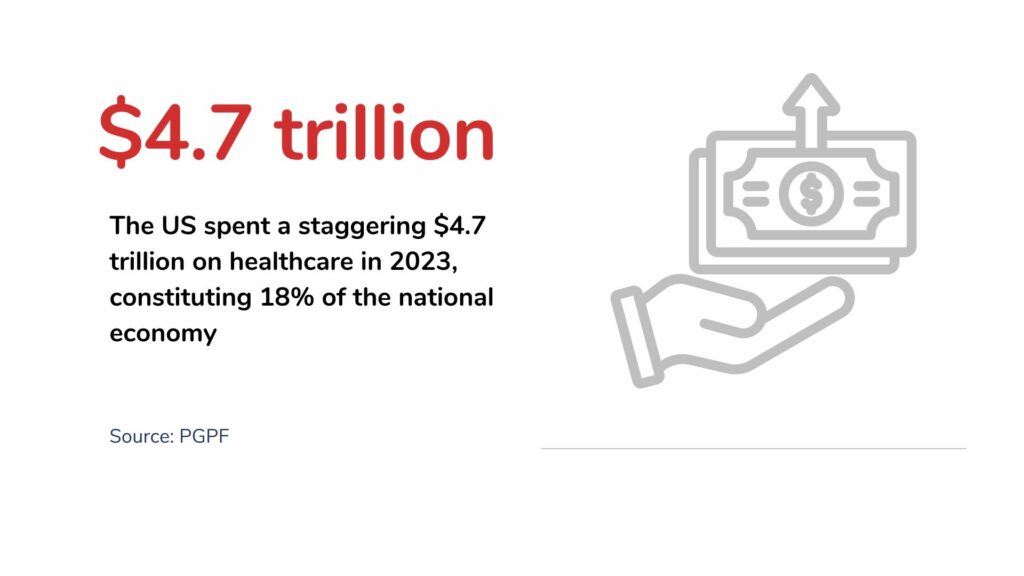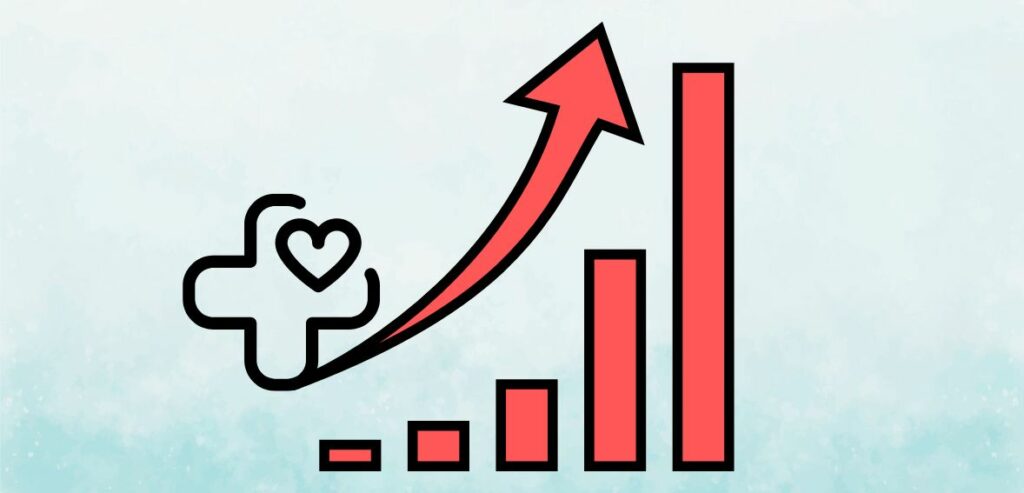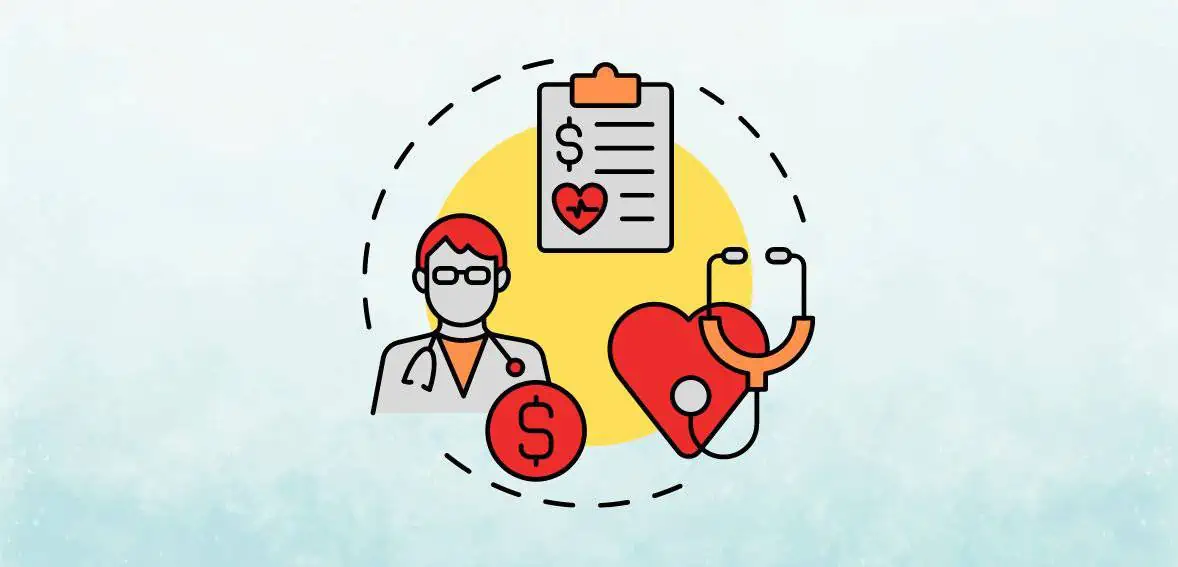Hospitals and healthcare systems are actively addressing cost management challenges, aiming for financial predictability in an industry known for its unpredictability. The United States, hosting the world’s most expensive healthcare system, spent a staggering $4.7 trillion on healthcare in 2023, constituting 18% of the national economy. Despite the dedication of well-intentioned and well-trained clinicians, the healthcare sector faces persistent escalating costs and inconsistent quality. So what is the relationship between healthcare practices and inflation and how will the healthcare industry take care of the rising price?

In this context, healthcare leaders and policymakers have attempted numerous incremental solutions without achieving significant improvements. Striking a delicate balance between cost control and delivering positive patient experiences remains a critical challenge. Effective cost-reduction strategies must prioritize patient health while exploring innovative avenues for expense reduction.
Healthcare systems that proactively manage operating expenses stand a better chance of success. However, cutting equipment, supplies, and staff costs may compromise a hospital’s ability to provide an excellent patient experience. In the face of escalating prices, healthcare practices must seek creative approaches to lower costs while maintaining a commitment to patient well-being. So, what other options do you have? Read on to learn more!
Healthcare Practices And Inflation: Current Position Of Healthcare In The US Amid Soaring Inflation

Amidst the highest inflation in the US in four decades, consumers are adjusting their shopping behaviors and reevaluating how they spend money. These shifts, driven by cost considerations, could potentially influence their healthcare decisions—a particularly relevant concern as healthcare affordability has long been a significant issue for US consumers. Complicating matters further is the historical trend of healthcare prices outpacing the overall economy’s rate of increase.
The peak of inflation in the US occurred in mid-2022 at 9.1%, a substantial surge compared to the previous year’s 3% increase in the consumer price index (CPI) as of June 2023. Traditionally, healthcare costs, encompassing insurance, medical services, equipment, and prescription drugs, have increased faster than other expenses in the broader economy.
However, in 2022, this pattern shifted, marking the first time in over thirty years that the overall inflation rate surpassed the rise in medical care costs. The longevity of this trend remains to be determined. Reports indicate a 34% decline in health insurance CPI. It’s important to note that the BLS health insurance index gauges insurers’ profits post-medical service payments, which is the primary reason the index decrease doesn’t directly reflect the actual premiums Americans pay.
Inflation’s Influence On Insurance
Presently, providers should shoulder the escalating healthcare input costs, but it’s only a matter of time before these costs trickle down to the payers. Ultimately, employers and private consumers will pass the resulting cost hikes.
Healthcare industry experts, business leaders, and economists anticipate a surge in health coverage expenses and medical costs that will be high. This is attributed to revenue, supply chain, and wage constraints that impacted hospital and clinic margins during the pandemic.
Inflation’s Impact On Consumers
The fluctuating economic landscape reshapes how Americans prioritize healthcare over other needs. Recent consumer surveys indicate a shift in Americans’ attitudes toward healthcare utilization and the consumption of healthcare services due to cost concerns. Consumers are more likely to face unmet healthcare needs and accumulate higher medical debt due to inflation.
In response to these challenges, the government has introduced the new Inflation Reduction Act that will alleviate the impact of inflation on millions of Americans. The healthcare provisions within the IRA aim to reduce out-of-pocket drug expenses for individuals with Medicare and cap Medicaid prescription drug spending. As most Americans receive subsidies, increases in insurance premiums are expected to result in heightened federal spending on subsidies.
Could Inflation Affect the Health Of US Consumers?

Approximately 28% of consumers feel less equipped to manage unexpected healthcare costs. With 339 million adults residing in the United States, this equates to around 95 million US adults feeling ill-equipped to handle healthcare expenses.
Among the nearly 4-tenths of Americans worried about covering unexpected healthcare needs, 18% stated that the most significant expense they could manage solely with their savings was under $100. According to the latest household survey by the Fed, 35% of Americans reported being financially worse off than a year ago.
In response to escalating personal expenses, confident consumers are postponing routine care, including cancer screenings, preventive measures, and other vital medical services. Delays in regular care may worsen health conditions and lead individuals to resort to high-cost settings like emergency departments, especially when minor health issues escalate into significant concerns.
Ways Inflation Is Affecting The Costs Of Healthcare Practices

Increase In Labor Costs
In the healthcare sector, historical inflation (depicted by the blue line) has closely correlated with the wage growth for healthcare workers. This connection is logical considering the labor-intensive nature of healthcare, where labor contributes to over 80% of the sector’s output. In January 2023, healthcare wages saw a year-over-year increase of 4.2%, slightly lower than the 4.4% wage growth in the private sector.
Despite substantial wage pressures in recent years, PCE (Personal Consumption Expenditures) healthcare services inflation has surprisingly remained subdued. Nevertheless, the tightening margins for healthcare service providers due to higher wages will likely increase PCE inflation for healthcare services. As of August 2023, hospital payrolls have experienced a continuous rise for 19 consecutive months, with payrolls standing 2.1% higher than in February 2020.
Cost Growth Of New Healthcare Technology
Adopting newer healthcare technologies has undoubtedly improved health outcomes and life expectancy. However, the rising inflation on these advanced systems and tools comes with a downside—escalating medical expenditures and the potential overuse of costly technology.
Many people link advanced technology and contemporary medical procedures with enhanced healthcare, and while this correlation is important, it undeniably comes at a higher cost.
When patients and healthcare professionals seek the latest treatments and state-of-the-art machinery, the overall healthcare costs rise for the entire population, necessitating financial support even from those who may not opt for the latest technology. Consider the following examples:
1. Diagnostic Imaging Systems:
- X-ray Machines: Advance X-ray units today range from $35,000 to $200,000. The increased expense is attributed to the advanced technology, superior image quality, and quicker processing times that these systems provide.
- Ultrasound Machines: These machines can cost between $5,000 and $200,000, while used machines may start from around $5000 to $40,000.
- MRIs: The MRI machine price, on average, is a staggering $1 million, requiring a customized room to prevent interference from other medical imaging studies. The total cost includes professional, facility fees, and technical help.
- CT Scans: The costs of a computed tomography machine can range from $200,000 to $3,000,000 (one-third the price of an MRI).
2. New Biotechnology Products:
Developing a new drug and bringing it to market costs approximately $897 million. The average cost of developing a new biotechnology product is $1.2 billion.
Impacts Of Inflation On Health and Safety
As inflation escalates, organizations may face challenging financial decisions with potential repercussions for health and safety measures. These effects include:
- Reduced Budgets: The continuous rise in inflation can compel organizations to make difficult financial choices, leading to diminished budgets for health and safety. This may translate into insufficient training, outdated equipment, or postponed maintenance, ultimately jeopardizing the well-being of employees.
- Cost-Cutting Measures: To navigate economic pressures stemming from inflation, some organizations might resort to cost-cutting measures that compromise the effectiveness of their health and safety programs. For instance, they may opt for cheaper, lower-quality personal protective equipment (PPE) or skip essential safety inspections.
- Increased Stress and Workload: Financial stress triggered by inflation can result in heightened workload and extended working hours as organizations strive to uphold productivity. This stress level surge may adversely affect employee health, increasing the likelihood of accidents and injuries.
- Lower Morale and Employee Engagement: Financial hardships can create a tense work environment, leading to diminished morale and reduced employee engagement in health and safety initiatives. Disengaged employees are less likely to adhere to safety protocols, elevating the risk of accidents.
How Can Healthcare Facilities Avoid Cost Increases From Inflation?
1. Optimizing Patient Flow With Practice Management Bridge
Traditionally, patients sought healthcare services where needed, whether in the emergency room, ambulatory setting, or inpatient facilities. In recent years, however, case management professionals have played a vital role in refining patient navigation and reducing hospital stays, gaining better control over healthcare access. This enhanced control is a crucial step for Practice Management Bridge in effectively managing the demand for their services.
Healthcare organizations should adopt a business-minded approach to assess capacity, determining the appropriate location for patients and the specific services they require. The effectiveness of this control also hinges on understanding the patient’s disease state. For instance, the PMB can automatically give you monthly reports on the revenue cycle. With proper analytics and reports, healthcare facilities can ensure that facilities can focus on budgeting, make room for improvements, and do much more to boost productivity and sales.
Healthcare providers should leverage tools and technology to deliver standardized care for patients with specific diseases and deviate only when necessary. This approach allows providers to manage resources based on capacity rather than merely striving to fill hospital beds, thus influencing the efficient utilization of resources in care delivery.
2. Ensuring Price Transparency And Providing Upfront Patient Cost Estimates
In light of the impact of inflation on patient spending priorities, many individuals are choosing to postpone healthcare. However, delaying treatment or rationing medications to save costs may result in compromised health outcomes, potentially leading to the necessity for more expensive treatments later.
Healthcare providers can proactively address this concern by furnishing patients with accurate pricing estimates before their scheduled care appointments. These estimates can be conveniently delivered to patients’ mobile devices, accompanied by user-friendly links to explore payment plans and methods. This proactive measure empowers patients to plan effectively, reducing the likelihood of payment defaults or delayed healthcare decisions.
3. Enhance Management Of Revenue Cycles
Revenue Cycle Management (RCM) systematically monitors all revenue generated from patient services. This tracking journey commences with account creation and concludes with the receipt of the final payment.
Several front-end functions play a pivotal role in expediting reimbursement timelines:
- Scheduling the initial appointment
- Patient registration, including demographic details
- Verifying eligibility for payment
- Fulfilling authorization/referral requirements
The subsequent step in the process is claims submission. All claims must include the necessary information to prevent denials and avoid the “black box” of uncollected accounts receivables. A critical aspect involves leveraging data analytics. Evaluating the performance of Revenue Cycle Management is essential for informing improvement strategies and decision-making processes. Key performance indicators (KPIs) offer valuable insights into the organization’s clinical, financial, and operational health.
4. Examining Healthcare Staff For Efficient Cost Management
Efforts to reduce costs in healthcare often involve a thorough examination of staffing. However, delving into staffing considerations for cost reduction doesn’t necessarily imply layoffs, especially in hospitals’ existing nursing shortages. Layoffs may not be a viable option. Instead, exploring other factors such as minimizing overtime, optimizing training, implementing recognition programs, and focusing on associate retention as integral components of a cost-cutting strategy becomes crucial.
Training and development play a pivotal role in the overall health of an organization, and their significance is widely acknowledged. Providing additional training and development opportunities not only enhances the skills of the staff but also serves as an incentive for associates to remain with the organization. This, in turn, can contribute to more substantial long-term cost reductions.
Healthcare providers also need to embrace digital health solutions that streamline clinical communication. Implementing an effective clinical communication tool enhances the delivery of patient care, reduces the risk of medical errors, and ensures compliance with HIPAA regulations. Simultaneously, physicians, nurses, radiologists, and other clinical staff members stand to benefit from improved communication, leading to less frustration throughout the workday. The ultimate outcomes are heightened job satisfaction, increased productivity, and an overall enhancement in patient care.
5. Assisting Patients In Uncovering Unidentified Insurance Coverage
As the continuous Medicaid enrollment concludes, numerous patients may face gaps in their coverage. Although primarily a concern for states to address, healthcare providers can play a role in aiding patients in discovering additional coverage options. Supporting individuals at higher risk is crucial by helping them access financial assistance and plan for forthcoming medical bills.
The PMB tool proves invaluable across various revenue cycle stages, identifying overlooked or forgotten billable coverage. Leveraging advanced search capabilities and proprietary data sources, PMB checks for both government and commercial insurance coverage. Upon discovering coverage, patients gain the assurance that their bills will be covered, while providers can avoid writing off these accounts as bad debt. Coverage Discovery operates on a contingency fee pricing model, ensuring that providers only incur costs for the tool when reimbursement occurs.
6. Expanding Telemedicine Opportunities
The significance of telemedicine became evident during the COVID-19 pandemic. In March 2020, it swiftly emerged as a primary method of receiving medical care. Fortunately, emergency legislation enacted at the pandemic’s onset facilitated payment for telehealth solutions.
Beyond the advantages of simplified billing and coding, other benefits have led medical practices to adopt telemedicine enthusiastically:
- Improved access
- Convenience for patients and providers
- Increased efficiency.
Telemedicine presents numerous avenues for providing efficient patient care without compromising quality. Successful telemedicine practices may prompt a reevaluation of real estate requirements.
Conclusion
As healthcare practices confront the challenges posed by inflation, strategic and thoughtful approaches are imperative to navigate the evolving landscape. The impact of inflation on healthcare costs is multifaceted, affecting everything from labor expenses to the adoption of advanced technologies. The recent shift in inflation dynamics, where the overall inflation rate has outpaced healthcare cost increases, adds a layer of complexity to the situation.
To prepare for the anticipated cost hikes, healthcare facilities must adopt proactive measures. Optimizing patient flow through tools like Practice Management Bridge, ensuring price transparency, and providing upfront cost estimates empower patients and enhance revenue cycles. Efficient cost management strategies involving staff examination, training optimization, and digital health solutions are pivotal in maintaining financial stability without compromising patient care. Moreover, assisting patients in uncovering unidentified insurance coverage can contribute to the financial well-being of both providers and individuals.
In this challenging environment, healthcare practices that embrace a comprehensive and innovative approach to cost management will be better positioned to weather the inflationary storm while maintaining a steadfast commitment to delivering high-quality patient care.
Frequently Asked Questions
Q: How does inflation impact healthcare business?
In simple terms, medical inflation refers to the rise in the cost of healthcare services over time. This upward trend significantly influences insurance premiums. As healthcare expenses increase, insurance companies bear a more significant financial burden to cover the costs associated with medical treatments and procedures.
Q: What are the primary cost effects of inflation?
The uneven price increase inevitably diminishes specific consumers' purchasing power in an inflationary environment. This erosion of real income stands out as the most significant cost of inflation. Additionally, inflation can distort purchasing power over time for those dealing with fixed interest rates, affecting both recipients and payers.
Q: How does health relate to economic growth?
Improved health among workers translates into higher performance levels and fewer absences. Good health conditions also empower individuals to pursue more education and skills. The direct impact of health on economic growth is evident through increased labor productivity and reduced costs associated with illnesses.
Q: What are some tips for Accelerating Cycle Time in Healthcare?
Healthcare providers can enhance their efficiency in treating patients by minimizing cycle times, consequently reducing the demand for resource capacity. For instance, decreasing patient waiting times lessens the need for constant supervision and space.
Accelerating cycle time improves outcomes by minimizing patient uncertainty and discomfort, reducing the risk of complications, and slowing disease progression. As providers optimize their processes and eliminate redundancy, patients can experience a more streamlined care cycle without enduring prolonged waiting periods.


